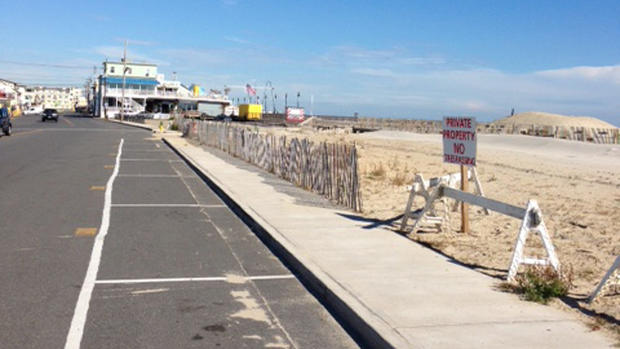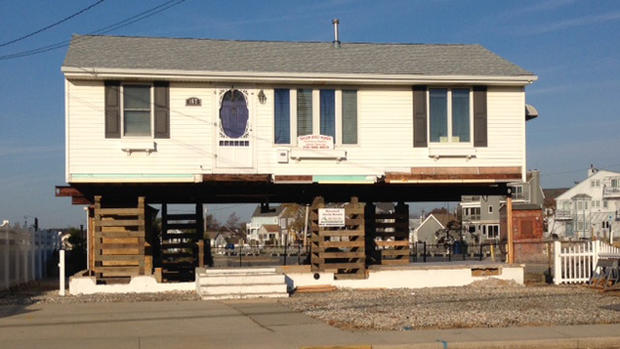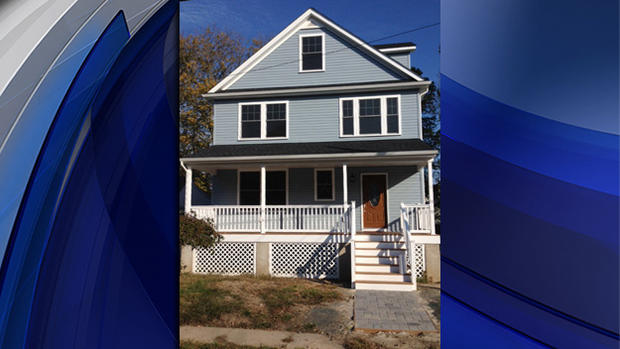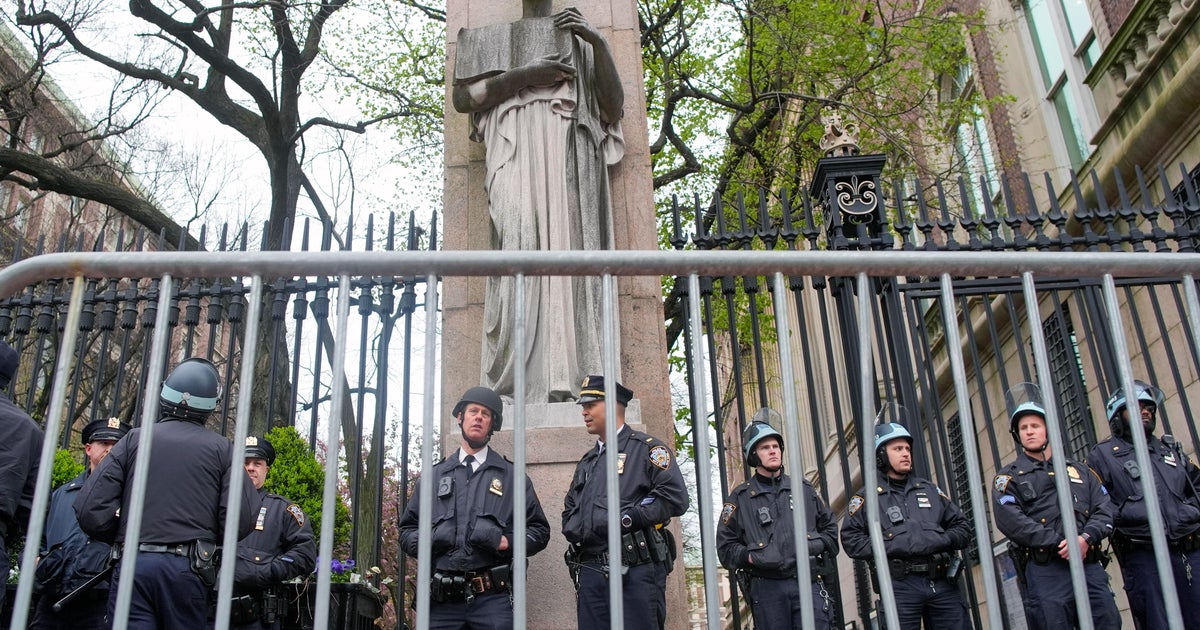Jersey Shore At Varying Stages Of Recovery Three Years After Superstorm Sandy
MANTOLOKING, N.J. (CBSnewYork) -- Three years after Superstorm Sandy, New Jersey is a work in progress.
More than 80,000 housing units were damaged or destroyed in the October 2012 storm. The cost: roughly $30 billion.
MORE SANDY ANNIVERSARY COVERAGE: Rockaways
Up and down the Jersey shore, you will find various stages of recovery, WCBS 880's Sean Adams reported. There's new construction -- stronger, fortified. There are elevated homes lifted above flood levels. But there are also structures still boarded up, shattered, broken, forlorn and forsaken.
One of New Jersey's wealthiest places took a direct hit: Mantoloking, where the raging storm surge swept away homes.
"We had originally, starting prior to the storm, 521 structures. We lost 200 structures -- a hundred from Mother Nature, another 91 or so that we had to physically take down because they were were deposited in the bay, they were deposited in our roadways," said Mantoloking police Chief Stacy Ferris.
"Right now, we're standing on top of a dune that's approximately 22 feet high," Ferris explained to Adams. "After the storm, there was nothing here. This was flat land, where the ocean was coming through. At this point, the DEP (Department of Environmental Protection) -- and we've partnered with our state and federal partners -- have installed a steel wall basically the length of town that goes 45 feet deep."
She said Mantoloking is making progress.
"Right now, we have only 112 vacant properties, which some of those will never be rebuilt," Ferris said. "Some of those have always been vacant. We just had 22 homes completed this year that had just come back on the tax maps, which is a huge success. Now you drive around and there's not really any more huge gaps where there used to be homes. We have maybe one or two. Some of those people are waiting for Army Corps. Some of those people are still fighting with their insurance companies. Some people are just not emotionally there.
"But we've gone leaps and bounds."
The stress and time, however, have taken a toll.
"We're seeing post-traumatic stress, believe it or not," Ferris said. "People are in varying degrees of recovery, including the town. We're seeing people just with the blank stares, people overwhelmed. Every now and then, you'll find a person who's just sitting there with tears in their eyes and you're wondering why."
Toms River, too, took a punch to the gut.
"When the ocean broke through the barrier island into Barnegat Bay, we responded to 542 911 calls within about an hour because all of a sudden people were standing on their kitchen tables or upstairs ... (or) maybe in an attic crawl space," Toms River Mayor Tom Kelaher said. "It was absolutely frightening."
Kelaher counts 10,000 damaged homes.
"We're coming back," he said. "From a dollar-and-cents point of view first of all, let me tell you that the state of New Jersey, along the coast, lost $4 billion in ratables -- 2 billion were right here in Toms River. And that's why the folks from the news media ... dubbed us 'Ground Zero of Superstorm Sandy.' Our tax accessor tells me over half of that has come back because of all of the new rebuilding.
"If you go over especially to the barrier island, there's so much construction," the mayor added. "If a guy is in the building trades and can't make a living here, he ought to just give it up because there's just such a need."
Kelaher said rebuilding doesn't occur overnight. It's complicated.
"You can go down the street and there could be six reasons why there's a problem -- second home, no coverage, people of modest circumstances don't have the money, people waiting for insurance claims or people waiting to see if the Army Corps is going to build the dunes before they spend the money to rebuild the place," he said.
So Toms River is trying to help.
"We hired a guy who's a retired insurance executive who's like a storm ombudsman," the mayor said. "The guy knows about every single program, and we've been able to help guide people and so on. ... Whatever we can do to help people, we're doing it because it's really our goal to get everybody back in their houses."
Back on the mainland, away from the beach, there's a silent struggle: food insecurity.
After Sandy, the local school district helped start The People's Pantry, which provides emergency food to about 23,000 Ocean County residents on a regular basis.
"People are absolutely still struggling from Sandy, but I don't think anyone realized the need was going to grow for people who weren't directly impacted by Sandy by losing so many ratables," said the pantry's executive director, Pat Donahue. "Our taxes have gone up, our utility rates have gone up -- and people were living on the edge before."
The People's Pantry caught the eye of the The FoodBank of Monmouth and Ocean Counties and Jersey rocker Jon Bon Jovi. They're teaming up to open a food hub and restaurant.
"The Bon Jovi Foundation is bringing in their Soul Kitchen," Donahue said. "It's a recommended donation of $10, and if you can, pay it forward to the next person. If you can't afford to pay for your meal, you volunteer and you get a voucher. It's just a remarkable thing because you can actually see a family come in and sit down with their children, and they're eating food that is well-balanced, nutritious food."
Meanwhile in Seaside Heights, business is solid on the boardwalk.
"I remember when the sun came up on the first day after the storm. I was here, and it was like we were on Mars. It was just unbelievable," said Seaside Heights spokesman Michael Graichen. "But (today), the boardwalk and the beach areas are very, very strong. A lot of our residents now are in completion of their rebuilding, and some of them are just continuing. So we're basically in good shape."
He said revenue for beach businesses was about the same this past summer as it was in 2012.
"The only problem that we do have is around our areas that there's a lot of housing that's still missing," Graichen said.
There was salt in the wound, however, when a massive fire consumed the southern end of the boardwalk in 2013.
In Manasquan, Mayor George Dempsey recalls the recovery after Sandy "was a nightmare in the beginning. It was so hard to get anything done and make any headway.
"We had over 50 percent of the houses in Manasquan damaged to some extent -- either just water in them or hurt very badly to where they had to be torn down," he said. "And in the last three years, the people have torn down 211 houses. We've had elevations done for 130 houses so far."
Dempsey said one of the big challenges for homeowners has been securing aid.
"The FEMA money is very slow in coming, and it's not coming to us directly," the mayor said. "It goes to the state of New Jersey, and then they dole it out."
On the state side, the big push now is to get folks home.
"Our housing program alone, RREM (Rehabilitation, Reconstruction, Elevation and Mitigation), we are projecting to secure about 8,000 homeowners, and we already have about 7,600 of them that have received a payment from that program indiciating that they're in construction," said David Reiner, deputy commissioner of the state's Department of Community Affairs.
About 2,000 have completed their rebuilding, he said.
It's a long road back for some businesses, too, in Sea Bright.
Tim McLoone's new Rum Runner restaurant and bar is 12 feet off the ground and looks like a Martha's Vineyard home with cedar shakes.
"Initially, I think there was a lot of doubt as to whether we should even do it," he said. "I think there was a lot of nervousness, but my wife and I basically decided we met in this building and we thought that we were also part of the fabric of Sea Bright, and if we could just be a small percentage of this town's recovery, it was worth it. The hard part became, of course, the financing."
McLoone said it's not just about business.
"I just had a romantic attachment to this town," he said.
Teresa Keefe in Belmar knows about all the bureaucracy involved in rebuilding. It has taken three years for her family to finally spend the night in their house.
When insurance money ran out, Keefe was left with half of a new home and no options.
"It was like having another full-time job. It was horrible," she said. "We ended up doing things ourselves. It was at the point where it couldn't happen anymore. We weren't even going to go through it. It was too stressful."
Belmar Mayor Matt Doherty started an online fundraising campaign to get the last two Belmar families back home.
Perfect strangers came through.
"To everyone involved ... we thank you from the bottom of our hearts," Keefe said. "You have no idea what this all means to us."






